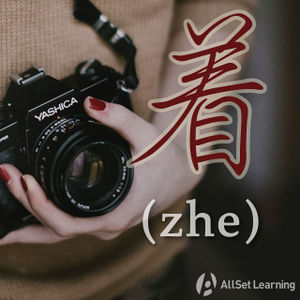Difference between revisions of "Expressing actions in progress (full form)"
| Line 6: | Line 6: | ||
<div class="jiegou"> | <div class="jiegou"> | ||
| − | + | Subj. + 正在 + Verb + 着 + Obj. + 呢 | |
</div> | </div> | ||
| Line 89: | Line 89: | ||
[[Category:B1 grammar points]] | [[Category:B1 grammar points]] | ||
| − | {{Basic Grammar|正在|B1|正在 + | + | {{Basic Grammar|正在|B1|正在 + Verb + 着 + 呢|这 件 事情 我 <em>正在 处理 着呢</em>。|grammar point|ASGEYQ9O}} |
{{Rel char|正}} | {{Rel char|正}} | ||
{{Rel char|在}} | {{Rel char|在}} | ||
Revision as of 08:53, 19 October 2016
-
Level
-
Similar to
-
Used for
-
Keywords
You may have learned that 在 (zài) and 正在 (zhèngzài) can be used before verbs to express that an action is ongoing or in progress. They are used to create the Mandarin equivalent of present continuous in English. But that pattern is actually a part of a longer, fuller pattern. It's rarely used in its full form, but bits and pieces of it are frequently used in everyday speech, so it's important to know the full form, even if you don't use it regularly yourself.
Structure
Subj. + 正在 + Verb + 着 + Obj. + 呢
It's important to remember that virtually every part of the above pattern is optional, so you're going to see all sorts of variations of it (and rarely the full form). The most common variation is just the "在 + V" pattern that you probably already learned long ago. Another common variation is "正 + V" pattern.
Examples
Some examples using the verb phrase 上汉语课:
- 我们 在 上 汉语 课。
- 我们 在 上 汉语 课 呢。
- 我们 在 上 着 汉语 课 呢。
- 我们 正在 上 汉语 课。
- 我们 正在上 汉语课 呢。
- 我们 正在上 着 汉语课 呢。
- 我们 上 汉语 课 呢。
- 我们 上 着 汉语 课 呢。All these sentences mean "We are having a Chinese lesson."
Some examples using the verb phrase 看报纸:
- 她 在 看 报纸。
- 她 看 报纸 呢。
- 她 看着 报纸 呢。
- 她 正在 看 报纸。
- 她 正 看 报纸 呢。
- 她 正 看 着 报纸 呢。All these sentences mean "She is reading the newspaper."
Some examples using the verb phrase 喝啤酒:
- 我 在 喝 啤酒。
- 我 喝 啤酒 呢。
- 我 喝 着 啤酒 呢。
- 我 正在 喝 啤酒 呢。
- 我 正 喝 啤酒 呢。
- 我 正 喝 着 啤酒。All these sentences mean "I am drinking beer."
Some examples using the separable verb 唱歌:
- 他们 正在 唱歌。
- 他们 正 唱 着 歌。
- 他们 唱 着 歌。
- 他们 唱着 歌 呢。All these sentences mean "They are singing."
See also
Sources and further reading
Books
- Chinese Grammar Without Tears (简明汉语语法学习手册) (pp. 54-7) →buy
- Common Chinese Patterns 330 (汉语常用格式330例) (pp. 321) →buy
- Mandarin Chinese: A Functional Reference Grammar (pp. 217-26) →buy
- Modern Mandarin Chinese Grammar: A Practical Guide (pp. 216-8) →buy
- Integrated Chinese: Level 1, Part 2 (3rd ed) (pp. 106-7) →buy
- 40 Lessons for Basic Chinese Course (基础汉语40课上册) (p. 157)→buy
Websites
- ChinesePod: Qing Wen - The 着 (zhe) Chronicles: Actions in Progress (free podcast content)



